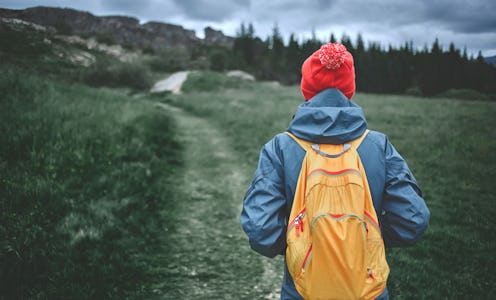Life
4 Science-Based Hacks To Fit Even More In Your Suitcase

Whether you're packing a bag to visit your parents for the holidays or looking at six weeks' worth of clothing for a trip to Europe, the struggle to be efficient with your packing can be highly confusing. Everybody has their "own" system, but it turns out that looking at the science of packing can actually help with many different aspects of travel, from fitting the right things into your suitcase to preventing your bag from going AWOL when you fly.
I'm a packing veteran and daughter of two packing parents who shuttle regularly between the hemispheres, and I can tell you that there is always a way to pack more efficiently — stuff soft things inside your shoes! Fill gaps with small items like socks! Invest in non-crumple clothing! — but that efficiency doesn't matter if you end up over your baggage limit. Always check the weight and size regulations for your carrier if you're going by air, and weigh your items before travel; if you end up getting over-excited and fitting half your life into a suitcase, you might have to repack half of it on the airport floor. So what's the best way to be smart about packing? Here are the best science-backed techniques.
1Combine Packing Techniques
Unfortunately, there hasn't been a definitive study about the best way to pack multiple materials in suitcases for travel (PhD students, get onto that, please). However, travel veterans tend to agree that the best method is, well, several methods. Folding, rolling, and organization superstar Marie Kondo's KonMari method — folding thinly and stacking vertically — are all widely deployed. Comparative experiments by CNet and Lifehacker have shown that, in real life, it's best to combine several methods. Rolling creases clothing but is more space-efficient, while folding keeps things neat. Roll casual items and fold expensive, delicate things on top.
If you've never heard of packing cubes and vacuum compression bags, they may also be your best friends. Packing cubes take piles of folded clothing and compress them to take up less space, while vacuum-compression bags use your vacuum to remove all the air from plastic packets of packed material. They're both huge space-savers if you're doing serious travelling or moving a lot of material — but the weight can add up, so don't neglect the scales.
2Prep For The Spread Of Bugs
Travel exposes you to new experiences — and, science says, new bugs. The Center for Disease Control and Prevention notes that travelers are particularly vulnerable to picking up and spreading illnesses and nasties, and packing can play a big role in how you deal with that. If you or anybody in your home has been ill before or during travel, clean all clothing before you travel, and if you're going to an area where malaria is prevalent, pack proper mosquito repellent and treat your clothes.
Travelers are also at risk of spreading a very annoying critter: bedbugs. A study in 2016 found that heating bags and their contents for six minutes at 70 degrees Celcius was a good way to combat bedbugs, but it's unlikely that you'll have the facilities to safely heat-treat your suitcase (no, don't put it in the microwave). Instead, heat-treat clothes themselves before you go or while you're at a bedbug-infested destination, using a hot dryer, to make sure you don't accidentally bring them with you.
3Do Your Research On Battery-Powered Devices
It pays to be scientific about your electronic devices when you travel. Popular Science magazine points out that, if you're going on a long journey, you should follow the manufacturers' advice on many electronic devices and make sure they have at least 50 percent charge before you turn them off and pack them. It's the healthiest thing for the devices themselves.
If your devices are going to be in use while you're travelling, do your research about how to charge them. Portable chargers and battery packs are now common, as are solar chargers and inverters, which use the charge from vehicles to charge devices like cameras.
4Guard Against Lost Baggage
According to statistics from SITA, which arranges IT for worldwide air traffic, in 2017 5.73 bags per thousand went astray on their way to their destination. Those might seem like relatively good odds for not losing your bag on your way to your destination, but if you consider the many thousands of passengers who pass through a single airport in a day — JFK alone saw 5.9 million passengers in 2016 — the risk that your bag will the one to disappear becomes a bit starker. Taking a scientific approach, the odds suggest you should take advantage of any opportunity to track your bags.
Those SITA figures are a big drop from previous years, in part, the company says, because people are using baggage trackers a lot. Bags that broadcast their location to your phone, and miniature tags that give you GPS details, are rising in popularity, according toThe New York Times. They're particularly good for people who travel often or have valuable materials in their cases.
However, even if you have the best baggage tracker in the business, knowing that your bag is currently in Lima while you're in Florida won't help you get a spare pair of underpants. Take a seasoned traveler's advice: always pack emergency clothing and toiletries in your carry-on, in case of delays or mislaid bags.
Even if you do everything right, baggage disasters happen: the carefully packed bottle of moisturizer explodes all over your cashmere, or your hand luggage smells puzzlingly of feet after a 12-hour flight. However, adopting a scientific approach can help you survive the worst travel issues and make your baggage work its hardest.